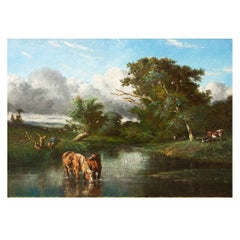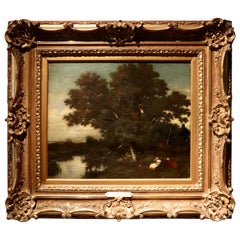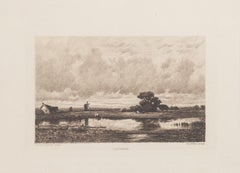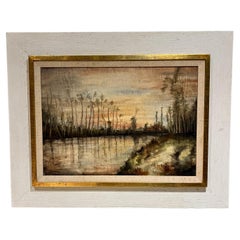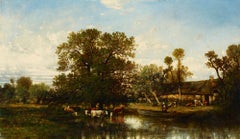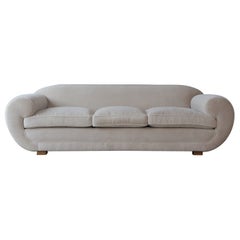Dupre Jules
to
14
54
45
68
31
23
22
17
8
7
5
5
5
4
2
2
2
2
1
1
1
1
1
1
1
1
9
9
8
6
3
Sort By
L'Abreuvoir - Etching after Jules Dupré - 19th Century
By Jules Dupré
Located in Roma, IT
L'Abreuvoir is an Etching print on paper realized by After Jules Dupré in the 1870s.
Titled and
Category
19th Century Barbizon School Figurative Prints
Materials
Etching
$270 Sale Price
25% Off
H 7.49 in W 8.67 in D 0.04 in
French Barbizon Pastoral Landscape Painting of Horses by Jules Dupré
By Jules Dupré
Located in Shippensburg, PA
mirror.
Academic notes: This particular landscape composition is one Jules Dupré revisited frequently in
Category
Antique 19th Century French Barbizon School Paintings
Materials
Canvas, Paint
$7,000
H 20.75 in W 26.38 in D 1.5 in
Barbizon School, French Painting, Atributed to Jules Dupré, Oil on Wood
By Jules Dupré
Located in Montreal, Quebec
Oil painting on wood attributed to Jules Dupré (1811-1889), a French artist famous for his dramatic
Category
Antique 19th Century French Barbizon School Paintings
Materials
Wood, Giltwood
$18,000 Sale Price
25% Off
H 17 in W 14.5 in D 1.5 in
Barbizon School Painting, Jules Dupré "Landscape by the River", Oil on Canvas
By Jules Dupré
Located in Montreal, Quebec
Rare, large and very beautiful oil painting by Jules Dupré (1811-1889), a French artist famous for
Category
Antique 19th Century French Barbizon School Paintings
Materials
Canvas, Wood
$118,400 Sale Price
20% Off
H 29.5 in W 33.25 in D 3.5 in
Paysage - Original Etching by C. Pinet after Jules Dupré - 19th Century
Located in Roma, IT
, engraver a sculptor, after Jules Dupré (French Painter; 1811-1889) .
Good conditions: as good as new
Category
19th Century Figurative Prints
Materials
Etching
$315 Sale Price
25% Off
H 4.53 in W 7.09 in D 0.04 in
French Landscape Art Impressionist Original Oil Painting signed
By Jules Dupré
Located in Chula Vista, CA
Dupre Dupree
suggestive of Julien Dupré French Artist
Original frame backing 1958 Beverly Hills Canon
Category
Mid-20th Century Mid-Century Modern Paintings
Materials
Wood, Paint
Twentieth Century Blue Toned Sunset Seascape of Boat in Wavy Seas Painting
By Jules Dupré
Located in Houston, TX
Biography: Jules Dupré was a French painter best known for his dramatic landscapes which depicted the sparse
Category
20th Century Realist Landscape Paintings
Materials
Oil
$18,000
H 35.375 in W 30 in D 3 in
Au bord d'un ruisseau
By Léon-Victor Dupré
Located in Barbizon, FR
sale of the Museum collection.
Younger brother and student of Jules Dupré, Léon-Victor Dupré worked in
Category
19th Century Barbizon School Landscape Paintings
Materials
Canvas, Oil
Elegant Sofa Upholstered in Pure Alpaca
By Émile-Jacques Ruhlmann, Jules Leleu, Pierre Chareau, Paul Dupré-Lafon
Located in LEWES, GB
A superb Art Deco style sofa, upholstered in pure Alpaca. High quality hand-made beech frames and newly upholstered in a soft, ivory, premium 100% alpaca fabric. Fast shipping worldw...
Category
2010s British Art Deco Sofas
Materials
Alpaca, Beech
Art Deco Cerused Oak French Dining Table, 1930's France
Located in New York, NY
. Clean modern vintage lines.
Same era as: Ruhlmann, Jean Dunand, Maurice Dufrene, Jacques Adnet, Dupre
Category
Mid-20th Century French Mid-Century Modern Dining Room Tables
Materials
Oak
French Jansen Style Verre Eglomise Mirror with Beautiful Border, France
Located in New York, NY
France.
Same era as: Ruhlmann, Jean Dunand, Maurice Dufrene, Jacques Adnet, Dupre´-Lafon, Jean Royere
Category
Mid-20th Century French Art Deco Wall Mirrors
Materials
Glass
$7,500
H 51 in W 39.5 in D 1 in
Ensembles Mobiliers, 18 volumes in 17 books
Located in Saarbrücken, SL
legendary names are represented, including Ruhlmann, Jean Dunand, Maurice Dufrene, Jacques Adnet, Dupre
Category
20th Century French Books
Materials
Paper
Beautiful Oak Art Deco French Sideboard
Located in New York, NY
, Maurice Dufrene, Jacques Adnet, Dupre´-Lafon, Jean Royere, Jules Leleu, Maxime Old, Eugene Printz, Andre
Category
Mid-20th Century French Mid-Century Modern Sideboards
Materials
Brass
Barbizon School, French River Landscape, Oil on Canvas, The Seine
Located in Cotignac, FR
, Narcisse-Virgile Diaz de la Peña, Jules Dupré, Constant Troyon, Léon Richet and Honoré Daumier.
François
Category
Late 19th Century Barbizon School Landscape Paintings
Materials
Oil
$1,105
H 12.21 in W 14.57 in D 1.38 in
Connais-tu le Pays (Primavera) apres J. Rolshoven (Do you Know the Country)
By Theophile Narcisse Chauvel
Located in Fairlawn, OH
, Jules Dupré , Narcissus Díaz de la Peña or Charles-François Daubigny. But it is in his engravings of
Category
1880s Barbizon School Figurative Prints
Materials
Etching
French Deco Wrought Iron Side Table Gueirdon Mirrored Top France, 1930, 1940s
Located in New York, NY
18 inches.
Same era as: Ruhlmann, Jean Dunand, Maurice Dufrene, Jacques Adnet, Dupre´-Lafon, Jean
Category
Vintage 1940s French Art Deco Side Tables
Materials
Iron
Impressionist Barbizon School River Landscape, Follower of Camille Corot
By Jean-Baptiste-Camille Corot
Located in Cotignac, FR
Rousseau, Charles-François Daubigny, Jules Dupré, Edouard Manet, Edgar Degas, Constant Troyon, Charles
Category
Late 19th Century Impressionist Landscape Paintings
Materials
Oil
$913
H 11.03 in W 13 in D 0.99 in
Two Maidens by a Stream after Narcissus Diaz de La Pena Barbizon - Original Oil
Located in Soquel, CA
began an apprenticeship in painting on porcelain at a china factory in Paris, where he met Jules Dupré
Category
1940s Post-War Figurative Paintings
Materials
Linen, Oil, Stretcher Bars
$3,250
H 30 in W 26 in D 2 in
Oscar Torna, River Landscape, Grez-Sur-Loing, Nocturne
Located in Cheltenham, GB
Fontainebleau, painters such as Charles-François Daubigny and Jules Louis Dupré were completing finished works
Category
1870s Naturalistic Landscape Paintings
Materials
Oil, Canvas
Courtship in the Forest French Romantic School XIX century oil on canvas
Located in Barcelona, Barcelona
scenes.
- Jules Dupré: Noted for his melancholy landscapes with rich, expressive use of light and color
Category
Late 19th Century Romantic Figurative Paintings
Materials
Canvas, Oil
$720 Sale Price
47% Off
H 11.42 in W 7.88 in
Large river edge with birds in France
By Edmond Yon
Located in BELEYMAS, FR
, friend artists most faithful to nature such as Théodore Rousseau, Camille Corot, Jules Dupré as well as
Category
1870s French School Landscape Paintings
Materials
Canvas, Oil
Le Berger et la Mer (The Shepherd and the Sea), 19th Century French Landscape
By Constant Troyon
Located in Beachwood, OH
, introduced him to Théodore Rousseau (1812-1867), Jules Dupré (1811-1889), and Narcisse Diaz de la Peña (1808
Category
19th Century French School Figurative Paintings
Materials
Oil
Ensembles Mobiliers 18 Volume (Book)
Located in North Yorkshire, GB
Ruhlmann, Jean Dunand, Maurice Dufrene, Jacques Adnet, Dupre´-Lafon, Jean Royere, Jules Leleu, Maxime Old
Category
20th Century Books
Materials
Paper
Constant Troyon Shepherdess After The Storm Large Oil Painting
By Constant Troyon
Located in Dallas, TX
Riocreux. Roqueplan introduced Troyon to Rousseau, Jules Dupré, and the other Barbizon painters, and in his
Category
1850s Barbizon School Animal Paintings
Materials
Canvas, Oil
$18,400 Sale Price
20% Off
H 38.5 in W 46.5 in D 5 in
Portrait of Madame Susanne, the Artist’s Wife
By Louis Valtat
Located in Sheffield, MA
studied under Gustave Moreau at the Ecole des Beaux-Arts and under Jules Dupre at the Academie Julian
Category
Early 20th Century Impressionist Portrait Paintings
Materials
Oil
Cottage Scene With Swans, oil on canvas, signed lower right
Located in PARIS, FR
friends Constant Troyon and Jules Dupré. He is buried in Paris in the Montparnasse cemetery (division 6
Category
19th Century Realist Landscape Paintings
Materials
Oil
$8,073
H 16.53 in W 22.83 in
Vintage french art by Louis Cabat - cottage in Normandy - oil on canvas, signed.
Located in PARIS, FR
, Cabat travelled to France and painted on location with his friends Constant Troyon and Jules Dupré. He
Category
Early 19th Century Realist Landscape Paintings
Materials
Oil
$5,406
H 15.55 in W 23.03 in
Baisch, Hermann 1846–1894: Mountain hut in Tyrol
By Hermann Baisch
Located in Gent, VOV
, Constant Troyon, Jules Dupré and the landscape painting of the Barbizon school, he went to Munich in 1869
Category
19th Century Landscape Paintings
Materials
Canvas, Oil
Cache En Prairie
By Constant Troyon
Located in Dallas, TX
Roqueplan, met by chance in the park of Saint-Cloud, introduced him to Théodore Rousseau, Jules Dupré (1811
Category
1850s Barbizon School Animal Paintings
Materials
Canvas, Oil
"Nymphs in a Landscape" Narcisse Diaz de la Peña, 19th Century Idyllic Landscape
Located in New York, NY
began an apprenticeship in painting on porcelain at a china factory in Paris, where he met Jules Dupré
Category
19th Century Romantic Figurative Paintings
Materials
Oil, Board
$5,200 Sale Price
20% Off
H 14.5 in W 16.25 in
Antique French Oil on Canvas Barbizon School Landscape Cows Victor Binet 1875
By Victor Binet
Located in Portland, OR
Constant Troyon, who along with Jules Dupre and Narcisse Diaz, formed the nucleus of the Barbizon School
Category
1870s Barbizon School Landscape Paintings
Materials
Canvas, Oil
$6,200
H 25 in W 28 in D 3.25 in
Nineteenth Century Assorted Flowers Still Life Painting
By Narcisse Virgilio Díaz de la Peña
Located in Houston, TX
Jules-Louis Dupré, with whom he became a lifelong friend.
He began copying paintings in the Louvre
Category
Mid-19th Century Realist Still-life Paintings
Materials
Canvas, Oil
$7,500
H 24.5 in W 32.375 in D 3 in
Antique, Pencil Portrait of a Woman
By Louis Valtat
Located in Los Angeles, CA
des Beaux-Arts and under Jules Dupre at the Academie Julian. As early as 1893 Valtat exhibited at the
Category
Early 1900s Drawings and Watercolor Paintings
Materials
Paper, Pencil
Painting by Hermann Baisch
By Hermann Baisch
Located in Belmont, MA
went to Paris and studied with Jules Dupré who introduced him to the Barbizon School.
After completing
Category
Antique 1880s German Barbizon School Paintings
Materials
Canvas
Eugène Cicéri (1813-1890) The Mill, original signed drawing
By Eugène Ciceri
Located in Paris, FR
where they were both influenced by their neighbors Théodore Rousseau, Jules Dupré, Narcisse Diaz, Johan
Category
1860s Romantic Landscape Drawings and Watercolors
Materials
Pencil
$1,021
H 12.01 in W 8.86 in
FORET DE FONTAINEBLEAU 19th C French Barbizon small oil pntg signed & published
By Narcisse Virgilio Díaz de la Peña
Located in New York, NY
porcelain factory where he met Gillet’s nephew, the painter Jules Dupré, who became a lifelong friend. He
Category
Mid-19th Century Barbizon School Paintings
Materials
Oil
Floral Still Life Country Flowers in a Vase by Flemish Barbizon artist in France
Located in Norwich, GB
the spearhead figures of the Barbizon movement, Jean François Milles and Jules Dupré.
Mols exhibited
Category
1880s Flemish School Interior Paintings
Materials
Oil, Panel
Berenice
By Louis Valtat
Located in Fairlawn, OH
Académie Julian (Julian Academy) under Jules Dupré (1811–1889), a landscape painter of the Barbizon school
Category
Early 1900s French School Portrait Prints
Materials
Woodcut
The River Bridge, Barbizon School, Circle of Jean Baptiste Camille Corot
Located in Cotignac, FR
Rousseau, Charles-François Daubigny, Jules Dupré, Constant Troyon, Charles Jacque, and Narcisse Virgilio
Category
Mid-19th Century Impressionist Landscape Paintings
Materials
Canvas, Oil
$4,144
H 14.75 in W 17.75 in D 1 in
Louis Valtat (1869-1952), Nature Morte Aux Pigeons
By Louis Valtat
Located in Dallas, TX
).
Valtat subsequently studied at the Académie Julian (Julian Academy) under Jules Dupré (1811–1889), a
Category
1920s Paintings
Materials
Paint
$34,400 Sale Price
20% Off
H 28 in W 25 in D 2.5 in
Bergère près des rochers
By Jean Ferdinand CHAIGNEAU 1
Located in Atlanta, GA
), Jean-Baptiste-Camille Corot (1796- 1875), Jules Dupre (1811-1889), Charles-Francois Daubigny (1817
Category
19th Century Academic Landscape Paintings
Materials
Oil, Panel
Bergère et son troupeau crépuscule, plaine de Barbizon
By Jean Ferdinand CHAIGNEAU 1
Located in Atlanta, GA
), Jean-Baptiste-Camille Corot (1796- 1875), Jules Dupre (1811-1889), Charles-Francois Daubigny (1817
Category
19th Century Academic Landscape Paintings
Materials
Oil, Panel
$10,920
H 6.1 in W 9.25 in
La Rentrée du Troupeau en Plaine de Barbizon
By Jean Ferdinand CHAIGNEAU 1
Located in Atlanta, GA
), Jean-Baptiste-Camille Corot (1796- 1875), Jules Dupre (1811-1889), Charles-Francois Daubigny (1817
Category
19th Century Academic Landscape Paintings
Materials
Oil, Panel
'Forest at Fountainbleau' Original Oil Painting on Board from Barbizon School
Located in Milwaukee, WI
joined by his disciples Jules Dupre and Narcisse Diaz de la Pena.
According to Anthea Callen, avant
Category
Mid-19th Century Barbizon School Landscape Paintings
Materials
Oil, Board
$6,960
H 19.63 in W 16.63 in D 2.75 in
"Young Girl (Jenue Fille)" Louis Valtat, French Drawing
By Louis Valtat
Located in New York, NY
, where he studied under Gustave Moreau at the Ecole des Beaux-Arts and under Jules Dupre at the Academie
Category
Early 20th Century Fauvist Figurative Drawings and Watercolors
Materials
Paper, Pencil
$2,000 Sale Price
20% Off
H 14.5 in W 13.25 in
Paysage du Berri - Etching and Aquatint After Théodore Rousseau - Late 1800
By Lucien Gautier
Located in Roma, IT
Jules Dupré.
This artwork is shipped from Italy. Under existing legislation, any artwork in Italy
Category
Late 19th Century Barbizon School Figurative Prints
Materials
Etching, Aquatint
$288 Sale Price
25% Off
H 11.42 in W 17.33 in D 0.04 in
Large landscape of a river in summer
By Edmond Yon
Located in BELEYMAS, FR
, friend artists most faithful to nature such as Théodore Rousseau, Camille Corot, Jules Dupré as well as
Category
1870s French School Figurative Paintings
Materials
Canvas, Oil
Narcisse Diaz De La Pena "Mary Magdalene Reading" Copper Panel
By Narcisse Virgilio Díaz de la Peña
Located in EVREUX, FR
Fontainebleau with enchantment. Very quickly, he settled there and found his friends: Jules Dupré, Constant
Category
Antique 19th Century French Paintings
Materials
Copper
Diaz De La Pena Narcisse "Madwomen of Love or Jealousy"
By Narcisse Virgilio Díaz de la Peña
Located in EVREUX, FR
a painter. He learns the use of colors and meets painters such as Jules Dupré, Raffet, Cabat or
Category
Antique Mid-19th Century French Paintings
Materials
Paint
Hero and Leander
By Ernst Oskar Simonson-Castelli
Located in Brussels & Antwerp, BE
academy of arts and in 1892 in Paris at the 'Académie Julian' under Jules Dupré (1811-1889), a landscape
Category
Antique 19th Century German Paintings
Jules Dupré Painting
By Jules Dupré
Located in Houston, TX
Jules Dupré (April 5, 1811–1889), French painter, was one of the chief members of the Barbizon
Category
Antique 1860s French Other Paintings
French, 19th Century Barbizon school 'The mail coach' by Jules Dupre
By Jules Dupré
Located in Petworth, West Sussex
Jules Dupre (French, 1811-1889)
The mail coach on its way from France to Spain
Signed J. Dupre
Category
19th Century Barbizon School Landscape Paintings
Materials
Canvas, Oil
$4,875
H 10.63 in W 13.88 in
Barbizon school DUPRE Landscape forest 19th French painting
By Jules Dupré
Located in PARIS, FR
Jules DUPRE (Attributed to)
Nantes, 1811 – L’Isle-Adam, 1889
Oil on wood panel
16.2 x 32.5 cm
As
Category
Mid-19th Century Barbizon School Landscape Paintings
Materials
Oil
Marine - catalogue raisonné n° 521
By Jules Dupré
Located in Barbizon, FR
one of the rare and vigorous marines of the great landscapist.
the sails are creamy-whiteand a gray-brown, in a strange light that colors a stormy sky and overspreads the wind-blown ...
Category
Late 19th Century Barbizon School Landscape Paintings
Materials
Oil
Early American Traditional European Cowboy Portrait
By Elizabeth Fullick
Located in Houston, TX
seven years abroad in Munich. Afterward, she studied under French artist Jules Dupre and Gustave
Category
Early 1900s Naturalistic Figurative Paintings
Materials
Oil
$1,800
H 26.5 in W 22.75 in D 3 in
The Rainbow
By Constant Troyon
Located in Saint Augustine, FL
Jules Dupré was a decisive moment for him. Dupré encouraged Troyon to work out in the open air, and
Category
Late 19th Century Barbizon School Animal Prints
Materials
Etching
Figure in Forest
By Narcisse Virgilio Díaz de la Peña
Located in Marlow, Buckinghamshire
worked in the same porcelain factory as Jules-Louis Dupré, with whom he became a lifelong friend
Category
Mid-19th Century Barbizon School Figurative Paintings
Materials
Oil, Panel
Les Decorateurs des Annees 40 by Bruno Foucart & Jean-Louis Gaillemin (Book)
Located in North Yorkshire, GB
Adnet, André Arbus, Dolt, Dominique, René Drouet, Paul Dupré-Lafon, Maurice Jallot, Jules Leleu, Jean
Category
20th Century Books
Materials
Paper
$525
H 12.25 in W 9.63 in D 1.25 in
- 1
Get Updated with New Arrivals
Save "Dupre Jules", and we’ll notify you when there are new listings in this category.
Dupre Jules For Sale on 1stDibs
An assortment of dupre jules is available on 1stDibs. Today, if you’re looking for editions of these works and are unable to find the perfect match for your home, our selection also includes. These items have been produced for many years, with earlier versions available from the 19th Century and newer variations made as recently as the 20th Century. Dupre jules available on 1stDibs span a range of colors that includes brown, beige, gray and more. Many versions of these artworks are appealing in their rich colors and composition, but Jules Dupre produced especially popular works that are worth a look. The range of these distinct pieces — often created in oil paint, paint and board — can elevate any room of your home.
How Much are Dupre Jules?
The average selling price for dupre jules we offer is $9,700, while they’re typically $403 on the low end and $118,400 for the highest priced.
More Ways To Browse
Antique Edger
1930s Modern Furniture
French Furniture 1930s
French Art Deco Dining Tables
1930s Art Deco Dining Table
Oak Sideboard Used Furniture
1930s Oak
1930s French Dining Tables
Prouve Perriand
Border Glass Mirror
French Oak Sideboard
French Midcentury Sideboard
Art Deco Mirror Top Table
Solid Oak Sideboards
French Horse Head
1940s Iron Table
Art Deco French Sideboard
Art Deco Mirrored Side Table

